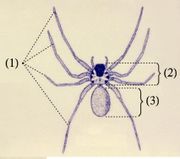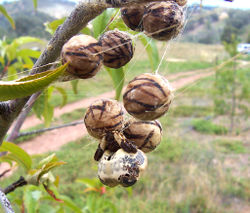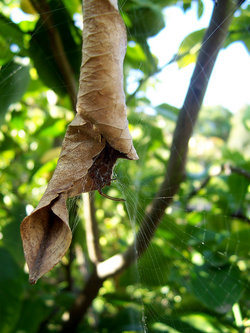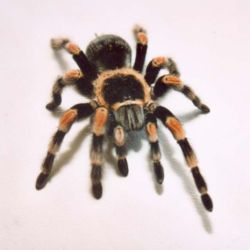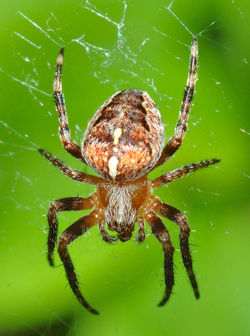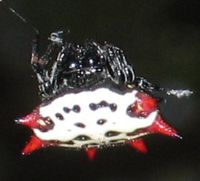Spider
2007 Schools Wikipedia Selection. Related subjects: Insects, Reptiles and Fish
| iSpider | ||||||||
|---|---|---|---|---|---|---|---|---|
 Orb-weaver spider at dawn in its web
|
||||||||
| Scientific classification | ||||||||
|
||||||||
| Diversity | ||||||||
| 111 families, 40,000 species | ||||||||
|
|
||||||||
|
Mesothelae |
Spiders are predatory invertebrate animals with two body segments, eight legs, no chewing mouth parts and no wings. They are classified in the order Araneae, one of several orders within the larger class of arachnids, a group which also contains scorpions, whip scorpions, mites, ticks, and opiliones (harvestmen). The study of spiders is known as arachnology.
All spiders produce silk, a thin, strong protein strand extruded by the spider from spinnerets most commonly found on the end of the abdomen. Many species use it to trap insects in webs, although there are many species that hunt freely. Silk can be used to aid in climbing, form smooth walls for burrows, build egg sacs, wrap prey, and temporarily hold sperm, among other applications.
All spiders except those in the families Uloboridae and Holarchaeidae, and in the suborder Mesothelae) (together about 350 species) can inject venom to protect themselves or to kill and liquefy prey. Only up to 200 species, however, have bites that can pose health problems to humans. Many larger species' bites may be painful, but will not produce lasting health concerns.
Morphology
Spiders, unlike insects, have only two body segments (tagmata) instead of three: a fused head and thorax (called a cephalothorax or prosoma) and an abdomen (called the opisthosoma). The exception to this rule are the assassin spiders, whose cephalothorax seems to be almost divided into two independent units. Except for a few species of very primitive spiders (family Liphistiidae), the abdomen is not externally segmented. The abdomen and cephalothorax are connected with a thin waist called the pedicle or the pregenital somite, a trait that allows the spider to move the abdomen in all directions. This waist is actually the last segment (somite) of the cephalothorax and is lost in most other members of the Arachnida (in scorpions it is only detectable in the embryos).
Cephalothorax
All spiders have eight legs, although a few ant-mimicking species use their front legs to imitate antennae, which spiders lack. Their eyes are single lenses rather than compound eyes, ranging from simple light/dark-receptors to eyes rivalling that of a pigeon (some jumping spiders).
They have pedipalps (or just palps), at the base of which are coxae or maxillae next to their mouth that aid in ingesting food; the ends of the palp are modified in adult males into elaborate and often species-specific structures used for mating. Since they don't have any antennae, they are using specialised and sensitive hairs on their legs to pick up scent, sounds, vibrations and air currents.
Because they can't chew their food, they have, like other arachnids, a tiny mouth they use as a short drinking straw to suck up the liquid parts of their prey. However, they are able to eat their own silk.
Sense organs
Spiders usually have eight eyes in various arrangements, a fact which is used to aid in taxonomically classifying different species. Most species of the Haplogynae have six eyes, although some have eight ( Plectreuridae), four (eg., Tetrablemma) or even two (most Caponiidae) eyes. Sometimes one pair of eyes is more well developed than the rest, or even, in some cave species, there are no eyes at all. Several families of hunting spiders, such as jumping spiders and wolf spiders, have fair to excellent vision. The main pair of eyes in jumping spiders even sees in colors.
Net-casting spiders have enormous, compound lenses that give a wide field of view and gather available light very efficiently.
However, most spiders that lurk on flowers, webs, and other fixed locations waiting for prey tend to have very poor eyesight; instead they possess an extreme sensitivity to vibrations, which aids in prey capture. Vibration sensitive spiders can sense vibrations from such various mediums as the water surface, the soil or their silk threads. Also changes in the air pressure can be detected in the search for prey.
Respiration and circulation
Spiders have an open circulatory system; i.e., they do not have true blood, or veins to convey it. Rather, their bodies are filled with haemolymph, which is pumped through arteries by a heart into spaces called sinuses surrounding their internal organs.
Spiders have developed several different respiratory anatomies, based either on book lungs, a tracheal system, or both. Mygalomorph and Mesothelae spiders have two pairs of book lungs filled with haemolymph, where openings on the ventral surface of the abdomen allow air to enter and diffuse oxygen. This is also the case for some basal araneomorph spiders like the family Hypochilidae, but the remaining members of this group have just the anterior pair of book lungs intact while the posterior pair of breathing organs are partly or fully modified into tracheae, through which oxygen is diffused into the haemolymph or directly to the tissue and organs. This system has most likely evolved in small ancestors to help resist desiccation. The trachea were originally connected to the surroundings through a pair of spiracles, but in the majority of spiders this pair of spiracles has fused into a single one in the middle, and migrated posterior close to the spinnerets.
Among smaller araneomorph spiders we can find species who have evolved also the anterior pair of book lungs into trachea, or the remaining book lungs are simply reduced or missing, and in a very few the book lungs have developed deep channels, apparently signs of evolution into tracheae. Some very small spiders in moist and sheltered habitats have no breathing organs at all, and instead breathe directly through their body surface. In the tracheal system oxygen interchange is much more efficient, enabling cursorial hunting (hunting involving extended pursuit) and other advanced characteristics as having a smaller heart and the ability to live in drier habitats.
Digestion
Digestion is carried out internally and externally. Spiders that do not have powerful chelicerae secrete digestive fluids into their prey from a series of ducts perforating their chelicerae. These digestive fluids dissolve the prey's internal tissues. Then the spider feeds by sucking the partially digested fluids out. Other spiders with more powerfully built chelicerae masticate the entire body of their prey and leave behind only a relatively small residue of indigestible materials. Spiders consume only liquid foods. Many spiders will store prey temporarily. Web weaving spiders that have made a shroud of silk to quiet their envenomed prey's death struggles will generally leave them in these shrouds and then consume them at their leisure.
Spinnerets
The abdomen has no appendages except from one to four (usually three) modified pairs of movable telescoping organs called spinnerets, which produce silk. The suborder Mesothelae is unique in having only two types of silk glands - thought to be the ancestral condition. All other spiders have the spinnerets further towards the posterior end of the body where they form a small cluster, and the anterior central spinnerets on the tenth segment are lost or reduced (suborder Mygalomorphae), or modified into a specialised and flattened plate called the cribellum (parts of suborder Araneomorphae), which produces a thread made up of hundreds to thousands of very fine dry silk fibers resulting in a woolly structure that traps prey. The cribellate spiders were the first spiders to build specialised prey catching webs. Later some groups evolved (called ecribellate) that use silk threads dotted with sticky droplets to capture prey ranging from small arthropods to sometimes even small bats and birds.
Life cycle
The spider life cycle progresses through three stages: the embryonic, the larval, and the nympho-imaginal.
The time between when an egg is fertilized and when the spider begins to take the shape of an adult spider is referred to as the embryonic stage. As the spider enters the larval stage, it begins to look more and more like an full grown spider. It enters the larval stage as a prelarva and, through subsequent moults, reaches its larval form, a spider-shaped animal feeding off its yolk supply. After a few more moults (also called instars) body structures become differentiated. Soon, all organ systems are complete and the animal begins to hunt on its own; it has reached the nympho-imaginal stage.
This stage is differentiated into two sub-stages: the nymph, or juvenile stage and the imago, or adult stage. A spider does not become sexually mature until it makes the transition from nymph to imago. Once a spider has reached the imago stage, it will remain there until its death. After sexual maturity is reached, the general rule is that they stop moulting, but the females of some non-araneomorph species will continue to moult the rest of their lives.
Many spiders may only live for about a year, but a number will live two years or more, overwintering in sheltered areas. The annual influx of 'outdoor' spiders into houses in the fall is due to this search for a warm place to spend the winter. It is common for tarantulas to live around twenty years.
Reproduction
Spiders reproduce by means of eggs, which are packed into silk bundles called egg sacs. Spiders often use elaborate mating rituals (especially the visually advanced jumping spiders) to allow conspecifics to identify each other and to allow the male to approach and inseminate the female without triggering a predatory response. If the approach signals are exchanged correctly, the male spider must (in most cases) make a timely departure after mating to escape before the female's normal predatory instincts return.
Sperm transmission from male to female occurs indirectly. When a male is ready to mate, he spins a web pad upon which he discharges his seminal fluid. He then dips his pedipalps (also known as palpi), the small, leg-like appendages on the front of his cephalothorax, into the seminal fluid, picking it up by capillary attraction. Mature male spiders have swollen bulbs on the end of their palps for this purpose, and this is a useful way to identify the sex of a spider in the field. With his palps thus charged he goes off in search of a female. Copulation occurs when the male inserts one or both palps into the female's genital opening, known as the epigyne. He transfers his seminal fluid into the female by expanding the sinuses in his palp. Once the sperm is inside her, she stores it in a chamber and only uses it during the egg-laying process, when the eggs comes into contact with the male sperm for the first time and are fertilized; this may be why the vivipary has never evolved in spiders.
Very unusual behaviour is seen in spiders of the genus Tidarren: the male amputates one of his palps before maturation and enters his adult life with one palp only. The palpi constitute 20% of the body mass of males of this species, and since this weight greatly impedes its movement, by detaching one of the two he gains increased mobility. In the Yemeni species Tidarren argo, the remaining palp is then torn off by the female. The separated palp remains attached to the female's epigynum for about four hours and apparently continues to function independently. In the meantime the female feeds on the palpless male.
Sacrificial males
It is a common belief that male spiders, which usually are significantly smaller than the females, are likely to be killed after or during mating, or sometimes even before mating can occur.
Even in some species of black widow, which are named exactly for this belief, the male may live in the female's web for some time without being harmed. However, the male of the closely related Australian redback spider is killed ritually by the females after it inserts its second palpus in the female genital opening; in over 60% of cases the female then eats the male. Males that 'sacrifice' themselves gain the benefit of increasing their paternity relative to males who do not get cannibalized, by feeding the egg-laying female.
In many other species, males are sometimes killed by females. In at least some of these cases it's likely that the males are simply mistaken as prey.
Ecology
Spiders have a great range of variation and lifestyle, although all are predatory.
While spiders are generalist predators, in actuality their different methods of prey capture often determine the type of prey taken. Thus web-building spiders rarely capture caterpillars, and crab spiders that ambush prey in flowers capture more bees, butterflies and some flies than other insects. Groups of families that tend to take certain types of prey because of their prey capture methods are often called guilds. A few spiders are more specialized in their prey capture. Dysdera captures and eats sowbugs, pillbugs and beetles, while pirate spiders eat only other spiders. Bolas spiders in the family Araneidae use sex pheromone analogs to capture only the males of certain moth species. Despite their generally broad prey ranges, spiders are one of the most important links in the regulation of the populations of insects. Every day on a meadow they devour over 10 g/m² of insects and other arthropods.
Behaviour
Spiders show a wide range of behaviour, from the ballet-like mating dances of certain jumping spiders to the seeming athletics of bolas spiders snatching their prey. Most diversity comes with the mode of predation, for example whether the spider waits for it in its orb web, or hunts it down.
Predatory techniques
There are many families of spiders, and the ways that they catch prey are diverse. But whether they catch insects, fish, small mammals, small birds, or some other small form of life, as soon as a spider makes contact with its prey it will generally attempt to bite it.
Spiders bite their prey, and occasionally animals that cause them pain or threaten them, to do two things. First, they inflict mechanical damage, which, in the case of a spider that is as large as or larger than its prey, can be severe. Second, they can choose to inject venom through their hollow fangs. Many genera, such as the widow spiders, inject neurotoxins that can spread through the prey's entire body and interfere with vital body functions. Other genera inject venom that operates to produce tissue damage at the site of the bite. Genera such as that of the brown recluse spider produce a necrotoxin. The necrotoxin is injected into prey where it causes the degradation of cell membranes. In the larger victims that do not die from these attacks, painful lesions over a fairly wide area of the body can remain active for fairly long periods of time. The spitting spiders have modified their poison glands to produce a mixture of venom and sticky substance that works as glue and immobilises the prey.
Although there are no vegetarian spiders, some species in the families Anyphaenidae, Corinnidae, Clubionidae, Thomisidae and Salticidae have been observed feeding on plant nectar. Several spider species are also known to feed on bananas, marmalade, milk, egg yolk and sausages in captivity.
Spider webs
Some spiders spin funnel-shaped webs, others make sheet webs, spiders like the black widow make tangled, maze-like, webs, and still others make the spiral "orb" webs that are most commonly associated with spiders. These webs may be made with sticky capture silk, or with "fluffy" capture silk, depending on the type of spider. Webs may be in a vertical plane (most orb webs), a horizontal plane (sheet webs), or at any angle in between. Most commonly found in the sheet-web spider families, some webs will have loose, irregular tangles of silk above them. These tangled obstacle courses serve to disorient and knock down flying insects, making them more vulnerable to being trapped on the web below. They may also help to protect the spider from aerial predators such as birds and wasps.
The spider, after spinning its web, will then wait on, or near, the web for a prey animal to become trapped. The spider can sense the impact and struggle of a prey animal by vibrations transmitted along the web lines.
Other species of spiders do not use webs for capturing prey directly, instead pouncing from concealment (e.g. trapdoor spiders) or running them down in open chase (e.g. wolf spiders). The net-casting spider balances the two methods of running and web-spinning in its feeding habits. This spider weaves a small net which it attaches to its front legs. It then lurks in wait for potential prey and, when such prey arrives, lunges forward to wrap its victim in the net, bite and paralyze it. Hence, this spider expends less energy catching prey than a primitive hunter such as the Wolf spider. It also avoids the energy cost of weaving a large orb-web. The diving bell spider does not use its web directly in prey capture, but has modified it into an underwater diving bell. Even species whose ancestors were building spiral orb webs have given rise to spiders who no longer make webs, for instance some Hawaiian spiny-legged spiders (genus Tetragnatha, family Tetragnathidae) which have abandoned web construction entirely.
Some spiders manage to use the 'signalling snare' technique of a web without spinning a web at all. Several types of water-dwelling spiders will rest their feet on the water's surface in much the same manner as an orb-web user. When an insect falls onto the water and is ensnared by surface tension, the spider can detect the vibrations and run out to capture the prey.
Hunting spiders
Many spiders do not build webs for catching prey. Some examples include:
- Brazilian wandering spider
- Brown recluse spider
- Huntsman spiders
- Jumping spiders
- Lynx spiders
- Nursery web spiders
- Spitting spiders
- Tarantulas
- Wolf spiders (Lycosidae)
- Yellow sac spider
- Assassin spider
Ambush predators
Some actively lure prey (the Bolas spiders) and may capture them with a sticky ball of silk on a line; others (like the crab spiders, trapdoor spiders, or the six-eyed sand spider) wait in a high-traffic area and directly attack their prey from ambush.
Defense
All spiders will attempt to protect themselves by biting, especially if they are unable to flee. Some tarantulas have a second kind of defense, a patch of urticating hairs, or urticating setae, on their abdomens, which is generally absent on modern spiders and Mesothelae. These ultra-fine hairs causes irritation and sometimes even allergic reactions in the attacker. Certain other species have specialized defense tactics. For example, the golden wheeling spider (Carparachne aureoflava) of the desert of Namibia escapes tarantula hawks (a species of wasp that lays its eggs in a paralyzed spider so the larvae have enough food when they hatch) by flipping onto its side and cartwheeling away.
Social spiders
A few species of spiders that build webs live together in large colonies and show social behaviour, albeit not as well evolved as in social insects. The most social species is probably Anelosimus eximius, which can form colonies of up to fifty thousand individuals.
Web types
Tangleweb spiders
Members of this group (family Theridiidae) are characterized by irregular, messy-looking, tangled, three-dimensional (non-sticky) webs, generally low and anchored to the ground or floor and wall. They are commonly found in or near buildings; some build webs in bushes. The spider generally hangs in the centre of its web, upside-down. Prey is generally ground-dwelling insects such as ants or crickets, in addition to small flying insects. These include the infamous black widows, the minute happyface spider, and thousands of other species.
Orb web spiders
Spiders in several families (eg., Araneidae, Tetragnathidae, Nephilidae) spin the familiar spiral snare that most people think of as the typical spider web. On average, an orb-weaving spider takes 30 minutes to an hour to weave a web. They range in size from quite large (6+ cm) to very small (<1 cm), but all are quite harmless to humans, beyond the shock entailed from walking into a face-height web and having a large spider dangling from your nose. Many of the daytime hunters have a 'ferocious' appearance, with spines or large 'fangs', but they are almost invariably inoffensive, preferring to drop on a dragline to the ground when disturbed, rather than bite, which can nevertheless be quite painful.
Other forms of webs
Many other groups spin webs in a variety of structural styles.
Some (the Linyphiidae) make various forms of bowl- or dome-shaped webs with or without a flat sheet or a tangled web above or below. Some make a flat platform extending from a funnel-shaped retreat, with generally a tangle of silk above the web. The common northern hemisphere 'funnel-web', 'house' or 'grass' spiders are only superficially similar to the notorious Sydney funnel-web spider, and are generally considered to be quite harmless. Some of the more primitive group Atypidae may make tubular webs up the base of trees, from inside which they bite insects that land on the webbing. These spiders look quite ferocious, but are not generally considered to be particularly dangerous to humans.
Evolution
Trigonotarbids, spider-like arachnids, were among the oldest known land arthropods. Like spiders, they were terrestrial, respired through book lungs, and walked on eight legs with two additional legs adapted to use around their mouth. However, they were not true spiders, not even ancestral to them, but represented independent offshoots of the Arachnida.
True spiders (thin-waisted arachnids) evolved about 400 million years ago, and were among the first species to live on land. They are distinguished by abdominal segmentation and silk producing spinnerets. The Pedipalpi (including whip scorpions) are believed to constitute the sister group to the Araneae.
Most of the early segmented fossil spiders belonged to the Mesothelae, a group of primitive spiders with the spinnerets placed underneath the middle of the abdomen, rather than at the end as in modern spiders (Opisthothelae). They were probably ground dwelling predators of other primitive arthropods. Silk may have been used simply as a protective covering for the eggs, a lining for a retreat hole, and later perhaps for simple ground sheet web and trapdoor construction.
As plant and insect life diversified so also did the spider's use of silk. Spiders with spinnerets at the end of the abdomen ( Mygalomorphae and Araneomorphae) appeared more than 250 million years ago, presumably promoting the development of more elaborate sheet and maze webs for prey capture both on ground and foliage, as well as the development of the safety dragline.
By the Jurassic, the sophisticated aerial webs of the orb weaving spiders had already developed to take advantage of the rapidly diversifying groups of insects. A spider web preserved in amber, thought to be 110 million years old, shows evidence of a perfect orb web.
The ability to weave orb webs is thought to have been "lost", and sometimes even re-evolved or evolved separately, in different breeds of spiders since its first appearance.
Taxonomy
Almost 40,000 species of spiders (order Araneae) have been identified and are currently grouped into 111 families by arachnologists, but because of difficulties in collecting these often very minute and evasive animals, and because of many specimens stored in collections waiting to be described and classified, it is believed that up to 200,000 species may exist.
The order is composed of three suborders. In the non-venomous primitive Mesothelae, body segmentation is clearly visible, demonstrating the link of spiders with their segmented arthropod ancestors.
The two other suborders, the Mygalomorphae (trapdoor spiders, funnel-web spiders, tarantulas) and the Araneomorphae ("modern" spiders), are sometimes grouped together as Opisthothelae. The latter account for about 94% of all spider species.
Mesothelae
The Mesothelae include the only recent family Liphistiidae. Two more families ( Arthrolycosidae and Arthromygalidae) are recognized from fossil evidence only.
The Liphistiidae are burrowing spiders only found in Southeast Asia, China, and Japan with about 90 species in 5 genera. Spiders of this remnant suborder are very rare, and are among the most " primitive" types of spiders in existence.
Recent Mesothelae are characterized by the narrow sternum on the ventral side of the prosoma. Several plesiomorphic characters may be useful in recognizing these spiders: there are tergite plates on the dorsal side and the almost- median position of the spinnerets on the ventral side of the opisthosoma.
Mygalomorphae
The Mygalomorphae are also called the Orthognatha, referring to the orientation of the fangs which point straight down and do not cross each other (cf Araneomorphae). This suborder includes the heavy bodied, stout legged spiders popularly known as tarantulas as well as the dangerous Australasian funnel-web spiders. They have ample poison glands that lie entirely within their chelicerae. Their chelicerae and fangs are large and powerful. Occasionally members of this suborder will even kill small fish, small mammals, etc. Most members of this suborder occur in the tropics and subtropics, but their range can extend farther toward the poles, e.g. into the southern and western regions of the United States and Canada, the northern parts of Europe and south into Argentina and Chile.
Araneomorphae
The Araneomorphae, (previously called the Labidognatha), are often known as the modern spiders. They are distinguished by having chelicerae that point diagonally forward and cross in a pinching action, in contrast to the Mygalomorphae (tarantulas and their close kin), where they point straight down. Most of the spiders that people encounter in daily life belong to this suborder, which makes up 94% of all spider species.
There are approximately 95 families in this suborder, ranging from the minute Patu digua (0.37 mm) to the big and flashy Argiope, from the common orb-weaver spiders to the abstruse assassin spiders, from the reclusive tree trapdoor spiders to the inquisitive jumping spiders.
Creatures often mistaken for spiders
In addition to the true spiders, there are several arachnids commonly mistaken for spiders, but which are not true spiders.
- Camel spider, a species of solifugid (also commonly called sun-spiders or wind-scorpions), are the source of many urban legends. In spite of their bad reputation they are actually harmless to humans, and have no venom.
- The daddy long-legs or harvestman is a member of the order Opiliones. These round-bodied arachnids have only two eyes and their heads are fused to their bodies. However, the name "daddy long-legs" is sometimes used to refer to cellar spiders, which have a similar leg shape; these are true spiders. Both are also often said to produce a deadly venom. While the harvestmen do not produce venom at all, the cellar spider's venom is completely harmless to humans.
Spiders and people
Spider bites
Most spiders are unlikely to bite humans because they do not identify humans as prey. Spiders, even small ones, may however bite humans when pinched. For instance, a common jumping spider (Family: Salticidae), around ⅜ inch (1 cm) long, when pinched between the folds of a human's palm may inflict a bite that is about as painful as a bee sting.
Spiders in the world which have been linked to fatalities in humans, or have been shown to have potentially fatal bites by toxicology studies of their venom, include:
- The Brazilian wandering spider
- The Australasian funnel-web spider
- The six-eyed sand spider, and possibly other spiders of genus Sicarius
- The widow spiders
- The recluse spiders
Spiders which likely are not deadly to humans, but which are nonetheless medically significant include:
- The hobo spider (this is doubtful, however)
- The yellow sac spider
- Certain species of tarantulas
- The false black widows
Spiders which can inflict painful bites (often similar to a bee sting), but whose bites generally do not cause any systemic or long-lasting effects, include:
- The huntsman spider
- The redback jumping spider (not to be confused with the very dangerous redback spider, the latter being one of the widow spiders).
None of these spiders will intentionally "come after you," but they should be removed from one's house to avoid accidental injury. Many authorities warn against spraying poisons indiscriminately to kill all spiders, because doing so may actually remove one of the biological controls against incursions of the more dangerous species by ridding them of their competition.
If dangerous spiders are present in your area, be mindful when moving cardboard boxes and other such objects that may have become the shelter of a poisonous spider. There is no need to be fearful; just do not grab a spider.
Arachnophobia
Arachnophobia is a specific phobia, an abnormal fear of spiders. It is among the most common of phobias. The reactions of arachnophobics often seem irrational to others (and sometimes to the sufferers themselves). People with arachnophobia tend to feel uneasy in any area they believe could harbour spiders or that has visible signs of their presence, such as webs. If they see a spider they may not enter the general vicinity until they overcome the panic attack that is often associated with their phobia. They may feel humiliated if such episodes happen in the presence of peers or family members. The fear of spiders can be treated by any of general techniques suggested for specific phobias.
Arachnophobia is also the title of a 1990 film, as well as a spin-off video game, in which (fictitious) deadly spiders overrun a small California town.
Spiders in symbolism and culture
There are many references to the spider in popular culture, folklore and symbolism. The spider symbolizes patience for its hunting with web traps, and mischief and malice for its poison and the slow death this causes. It symbolises possessiveness for its spinning its prey into a ball and taking it to its burrow (for burrowing species).

